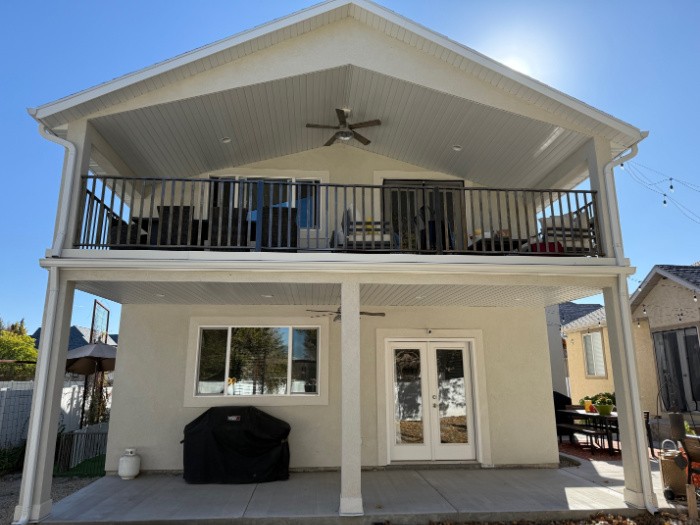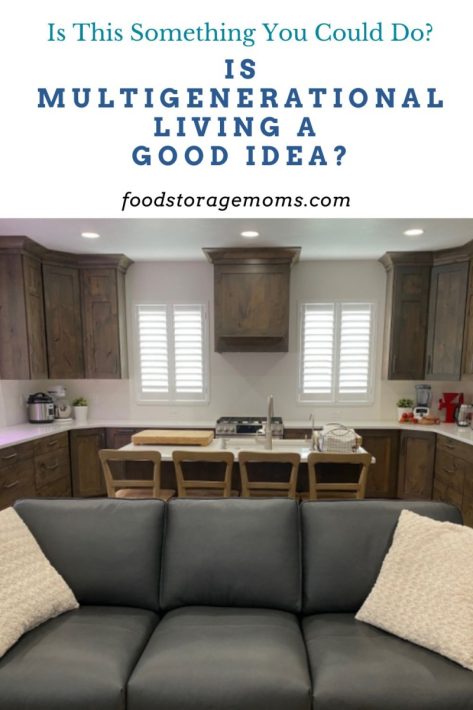
In recent years, multigenerational living—multiple generations of a family living under one roof has become more common. Rising housing costs, childcare needs, and a desire for stronger family bonds are bringing families back together. But is it truly a good idea? Let’s look at the pros, cons, and considerations before making the move.
You can buy a lot of acreage and build several homes together, or build an ADU behind an existing home. An ADU is an Accessory Dwelling Unit. We built an ADU in our daughter’s backyard. It measures 1,000 square feet per floor. We have the main floor.
The picture below shows my combined kitchen and living room. We don’t have room for a kitchen table, but our home is a size that we seldom have guests over for dinner.

The Benefits of Multigenerational Living
1. Shared Expenses
Living together can ease financial burdens. Families can split mortgage payments, utilities, groceries, and other household costs, saving everyone money.
2. Built-in Support System
From grandparents helping with childcare to adult children caring for aging parents, having multiple generations together creates a support network that benefits everyone.
3. Stronger Family Bonds
Shared daily life fosters connection and understanding across generations. Grandchildren get to know their grandparents more deeply, and traditions are more easily passed down.
4. Emotional Well-being
Companionship and a sense of belonging can reduce feelings of loneliness, especially among older adults.
The Challenges to Consider
1. Lack of Privacy
More people mean less personal space. Everyone needs boundaries and designated quiet areas to maintain harmony.
2. Conflicting Lifestyles
Different routines, parenting styles, or generational values can cause tension if not discussed openly.
3. Unequal Contributions
If some family members contribute more financially or otherwise, resentment can build over time. Clear agreements help avoid this.
4. Space Limitations
Not every home is designed for multiple generations. Renovations or additions may be needed to improve accessibility and comfort.
Tips for Making It Work
- Communicate openly before moving in together. Discuss finances, chores, privacy, and expectations.
- Create separate zones in the home for each family unit.
- Set boundaries early to maintain respect and independence.
- Plan for the future, especially regarding health care and long-term living arrangements.
Pros and Cons of Multigenerational Living
Pros
1. Financial Savings
Sharing a home means splitting costs, mortgage, utilities, groceries, and maintenance, making life more affordable for everyone.
2. Built-in Childcare and Elder Care
Grandparents can help care for young children, while adult children can support aging parents. This reduces outside care costs and keeps loved ones close.
3. Stronger Family Bonds
Daily interaction fosters deeper relationships across generations and helps preserve family traditions and values.
4. Emotional Support
Living together can reduce loneliness and increase feelings of belonging and security.
5. Efficient Use of Space
Instead of multiple homes, one well-planned household can meet everyone’s needs, often allowing for upgrades or larger shared spaces.
Cons
1. Limited Privacy
It can be difficult for each person or couple to have their own space, especially in smaller homes.
2. Generational Conflicts
Differences in parenting styles, routines, and opinions can lead to tension or misunderstandings.
3. Unequal Responsibilities
If financial or household duties aren’t clearly divided, resentment can grow.
4. Overcrowding
Too many people in one home can cause stress and reduce comfort, especially if there aren’t enough bedrooms or bathrooms.
5. Harder Transitions
When someone’s needs change, for example, a parent over 70 needing more care, it may require emotional and logistical adjustments for everyone.
Legal Contracts for Multigenerational Living
When multiple generations live under one roof, it’s essential to treat the arrangement like a partnership, transparent, fair, and legally protected. A well-drafted agreement helps prevent misunderstandings and protects everyone’s rights.
Why You Need a Legal Agreement
Even among family members, verbal promises can easily be forgotten or misinterpreted. A written contract helps:
- Define ownership and financial contributions
- Clarify living arrangements and household responsibilities
- Outline exit plans if someone needs to move out or sell their share
- Prevent potential disputes later
Key Legal Documents to Consider
1. Co-Ownership Agreement
If more than one person’s name is on the title, a co-ownership agreement should outline:
- Ownership percentages
- Who pays for what (mortgage, insurance, repairs, taxes)
- How decisions are made (renovations, refinancing, selling)
- What happens if one person wants to move or sell
2. Rental or Occupancy Agreement
If one generation owns the home and others are living there, this agreement defines:
- Monthly rent or contribution
- Duration of stay
- Maintenance or shared utility costs
- Rules for privacy, guests, and shared spaces
3. Estate Planning Documents
It’s vital to plan for the future:
- Update wills to reflect property interests or inheritance intentions
- Create a power of attorney and a healthcare directive for older family members
- Consider a family trust to simplify property transfer
4. Remodeling or Accessibility Agreement
If modifications are made (adding an in-law suite or separate entrance), clarify:
- Who pays for the upgrades
- Ownership of any new additions
- How those changes affect property value
Tips for Success
- Hire a real estate attorney or family law attorney experienced in co-living arrangements.
- Put everything in writing — even small details like utilities or chores.
- Revisit agreements annually as family needs change.
- How to Hire a Builder for Multigenerational Living Spaces
If your home needs an addition, remodel, or separate suite to make multigenerational living comfortable, hiring the right builder is essential. Whether you’re adding a basement apartment, converting a garage, or building an in-law suite, the process requires planning, budgeting, and the right professional help. - Step 1: Define Your Needs
Before contacting builders, outline your goals:
Will you need separate entrances or kitchens?
Are accessibility features (like ramps, wider doors, or walk-in showers) required?
Do you want soundproofing between living spaces for privacy?
Having a clear vision helps builders give accurate quotes and design ideas. - Step 2: Set a Realistic Budget
Include:
Construction costs
Permits and inspections
Design fees (architect or draftsman if needed)
Contingency fund (10–15% for unexpected expenses)
Remember, it’s often cheaper to renovate existing space than to build a complete addition, but not always. - Step 3: Research Local Builders
Look for builders who specialize in:
Home additions or remodels
Accessory dwelling units (ADUs). This is what Mark and I built in our daughter’s backyard.
Aging-in-place or universal design
Ask family, friends, or local neighborhood groups for recommendations. Check online reviews and verify their license and insurance status with your state’s contractor licensing board. - Step 4: Interview and Compare
Ask potential builders:
How many similar projects have they completed
If they provide references or site visits to past jobs
Estimated timeline and payment schedule
How they handle permits and inspections
Who will be your main point of contact during construction
Get at least three bids and compare not just the price, but also the quality of materials, design flexibility, and communication style. - Step 5: Review the Contract Carefully
Before signing, make sure your contract includes:
Scope of work and detailed project description
Itemized costs and payment schedule
Start and completion dates
Warranty information
Change-order procedures
Liability and insurance details
Never rely on verbal promises. Everything should be in writing. - Step 6: Stay Involved During Construction
Visit the site regularly, communicate openly with your builder, and document any agreed-upon changes. Keep copies of all invoices, receipts, and inspection reports.
Why Is Multigenerational Living Becoming So Popular?
In recent years, multigenerational living has shifted from being a rare arrangement to a mainstream lifestyle choice. Families across the U.S. are rediscovering the benefits of living under one roof, not just out of necessity, but also for practicality, connection, and shared values.
1. Rising Housing Costs
Home prices and rent have skyrocketed in many areas, making it difficult for younger generations to afford housing on their own. Sharing a home helps reduce the financial pressure and allows families to pool resources.
2. Childcare and Elder Care Costs
Daycare and assisted living facilities are expensive. By living together, families can care for both children and aging parents at home, saving thousands each year and ensuring loved ones receive personal attention.
3. Desire for Family Connection
After the pandemic, many families realized how valuable time together truly is. Living together fosters closer relationships, emotional support, and a sense of belonging that’s hard to find elsewhere.
4. Cultural and Generational Shifts
In many cultures, multigenerational living has always been the norm. Now, more Americans are embracing that model again, especially as families seek interdependence over independence.
5. Aging in Place
As Baby Boomers age, many prefer to stay close to family rather than move into senior living communities. Multigenerational homes allow older adults to age safely and comfortably while remaining part of daily family life.
6. Sustainability and Efficiency
Sharing one home rather than maintaining several reduces overall energy use, transportation costs, and environmental impact, making it an eco-friendly choice.
Final Word
Multigenerational living can be a wonderful experience that brings families closer, provides security, and supports one another through life’s stages. However, it requires planning, communication, and flexibility. If everyone is on board and expectations are clear, it can be one of the most rewarding living arrangements your family ever experiences.
Multigenerational living works best when everyone feels emotionally, financially, and legally secure and respected. A simple contract can save family relationships and ensure the arrangement is fair for all generations involved. Hiring the right builder can make your multigenerational home safe, functional, and comfortable for every family member. Take your time, do your research, and choose someone who understands both your budget and your family’s unique needs. May God Bless This world, Linda
The post Is Multigenerational Living A Good Idea? appeared first on Food Storage Moms.
from Food Storage Moms
No comments:
Post a Comment